The ocean is the largest ecosystem on Earth! It is extremely important due to the fact that it provides us with food, aids us in balancing our climate, and produces over half of the world’s oxygen. So, how is it possible that we humans continue to use it as our dumping sight- killing over one million animals every year?
This is list of just a few of the animals that are killed by our pollution everyday:
1. Whales and Dolphins
Whales and dolphins often mistake crustaceans, fish, etc for plastic. Whales especially have large mouths, leading to an intake of large amounts of trash unknowingly. In one case a marine expert dissected an already deceased whale to find that it had “88 pounds of plastic waste jammed into its belly.” Most plastics are pretty light in weight, so the fact that there was such a heavy amount in one whale is crazy!
2. Seabirds
One million seabirds are killed by pollution every year. The plastic that is consumed by seabirds can take up almost the entire storage of their stomach, causing extreme starvation. According to the Center of Biodiversity, “It’s estimated that 60 percent of all seabird species have eaten pieces of plastic, with that number predicted to increase to 99 percent by 2050.”
3. Sea Turtles
 While turtles are also known to be killed from ingesting plastics, they are widely affected by fishing netting and plastic soda rings. These pollutants become wrapped around the turtles neck and shell making it tough to breath and move around. A way of helping this issue is to make sure to cut your plastic soda rings before you throw it away. While you may be throwing it in a trash bin there is still a possibility of it ending up back in the ocean. Cutting soda rings can aid with other marine life as well.
While turtles are also known to be killed from ingesting plastics, they are widely affected by fishing netting and plastic soda rings. These pollutants become wrapped around the turtles neck and shell making it tough to breath and move around. A way of helping this issue is to make sure to cut your plastic soda rings before you throw it away. While you may be throwing it in a trash bin there is still a possibility of it ending up back in the ocean. Cutting soda rings can aid with other marine life as well.
Whether it’s recycling your own plastics or volunteering for ocean cleanup, just small gestures everyday can help our oceans immensely. When you’re debating on throwing a piece of trash on the ground or waiting for a recycling/trash bin, think back to these animals and how that one piece of trash could affect them.
Written by Skylar Griffin, revised and edited by Kailyn Hayes